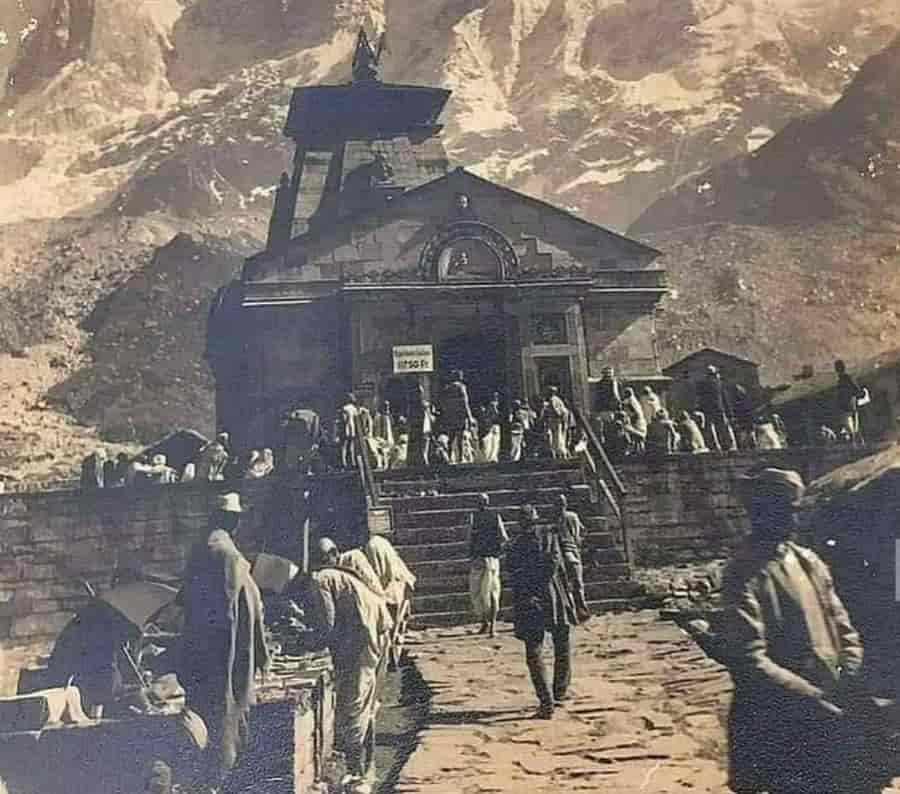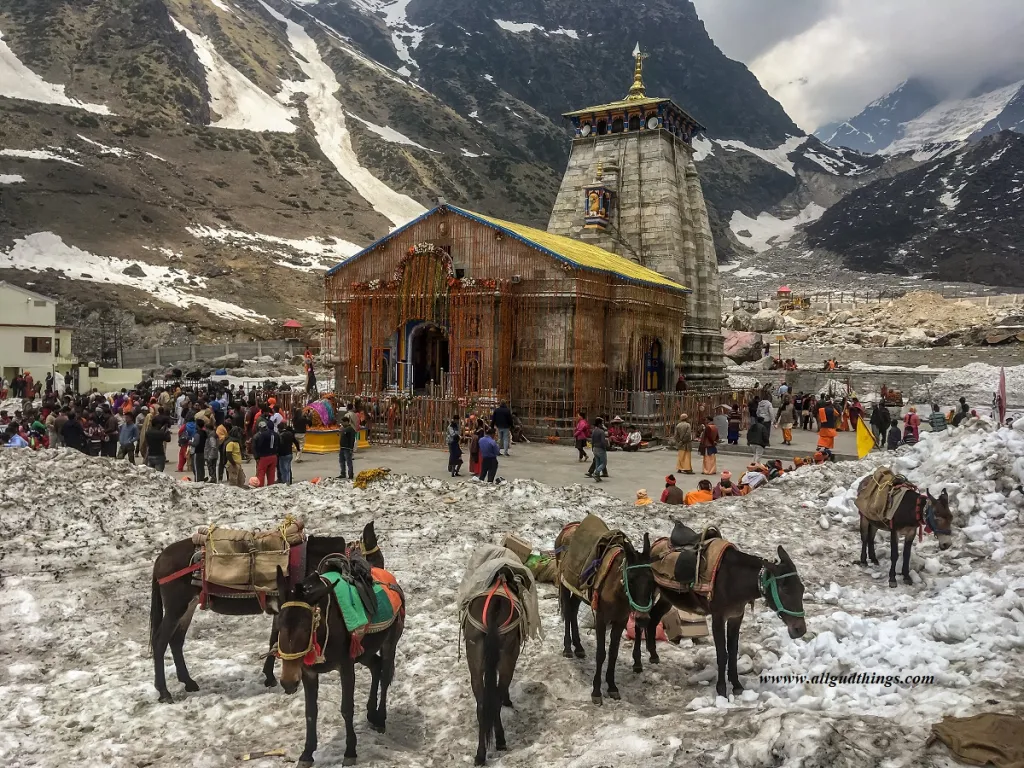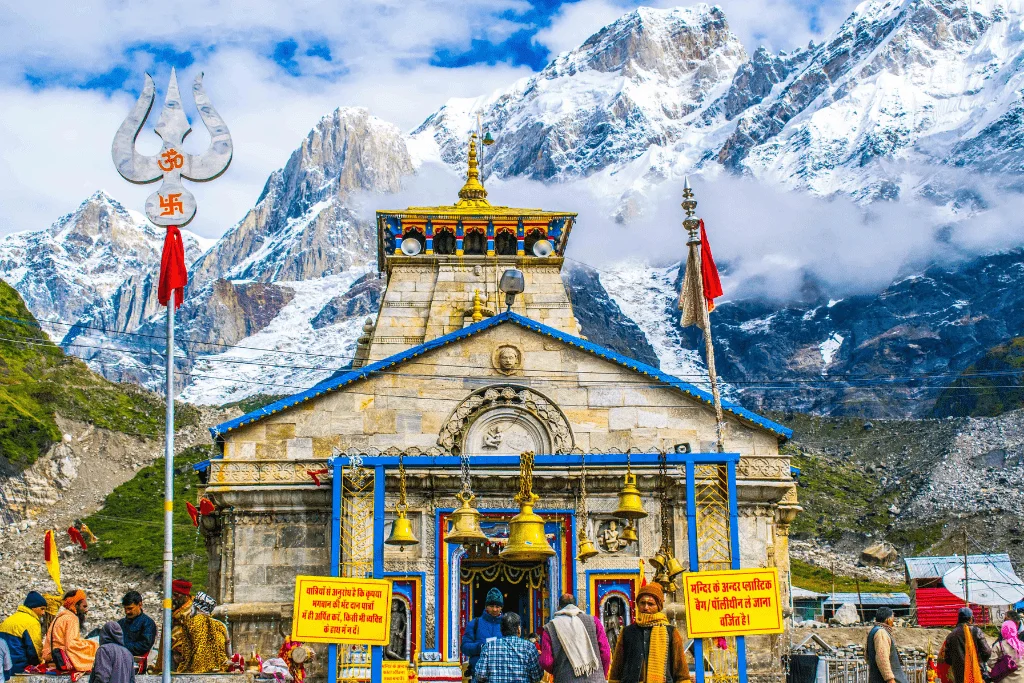KEDARNATH TEMPLE
Nestled amidst the towering peaks of the Garhwal Himalayas, the Kedarnath Temple stands as a testament to both faith and resilience. Perched at an altitude of 3,583 meters (11,755 feet) above sea level in the Rudraprayag district of Uttarakhand, India, this sacred Hindu shrine holds a profound significance in the hearts of millions of devotees. Its remote location, surrounded by breathtaking natural beauty, adds to its allure, drawing pilgrims and travelers alike from across the globe.
A Glimpse into History:

The history of Kedarnath Temple is steeped in legend and myth, tracing its origins back to Hindu mythology. According to ancient texts. The temple is believed to have been built by the Pandava brothers, protagonists of the epic Mahabharata, as an offering to Lord Shiva, the Hindu god of destruction and regeneration.
Legend has it that after the great Kurukshetra war, the Pandavas sought redemption for their sins of fratricide by seeking Lord Shiva’s blessings. However, Lord Shiva eluded them and took refuge in Kedarnath in the form of a bull. When he discovered something, he plunged into the ground, leaving behind a hump which is worshipped as the conical lingam, the symbol of Shiva, in the sanctum sanctorum of the temple.
The Spiritual Journey:
For devout Hindus, a pilgrimage to Kedarnath is not merely a journey of physical endurance but also a spiritual odyssey. The traditional pilgrimage route begins at Gaurikund, where devotees take a holy dip in the hot springs before embarking on a challenging trek of approximately 16 kilometers (10 miles) to reach the temple.
The trek, though arduous, is imbued with a sense of devotion and camaraderie. As pilgrims from diverse backgrounds traverse rugged terrain, chanting hymns and prayers in reverence to Lord Shiva. Along the way, one encounters picturesque landscapes, cascading waterfalls, and quaint villages, each adding a layer of enchantment to the pilgrimage experience.
Architectural Marvel:

The architecture of Kedarnath Temple is a marvel in itself, blending seamlessly with its natural surroundings. Constructed primarily of large, heavy slabs of grey stone. The temple exemplifies the ancient architectural style prevalent in the region. Its sturdy structure, designed to withstand the harsh mountain climate, is a testament to the craftsmanship of yesteryears.
The sanctum sanctorum houses the sacred lingam, adorned with flowers and offerings brought by devotees as symbols of their devotion. Smaller temples dedicated to Parvati, Ganesha, and Bhairava, surround the main shrine, enhancing the spiritual ambiance of the complex with their presence.
Resilience Amidst Adversity:
Over the centuries, Kedarnath Temple has weathered numerous natural calamities, including earthquakes, avalanches, and floods. However, its enduring resilience is a testament to the unwavering faith of the devotees and the enduring spirit of the human endeavor.
In June 2013, catastrophic floods and landslides ravaged the region, resulting in widespread destruction and loss of life.The temple complex suffered significant damage, with parts of it submerged under debris and the river waters.
Rebirth and Restoration:
After the 2013 disaster, people initiated efforts to rebuild and restore the Kedarnath Temple. Demonstrating the resilience and determination of the human spirit. The restoration project, undertaken by government agencies and private organizations, aimed to revive the sanctity of the shrine while ensuring its structural integrity and safety.
The reconstruction process involved meticulous planning and execution, employing modern engineering techniques without compromising the temple’s architectural integrity. In May, the temple was reopened to the public for its restoration, marking a new chapter in its storied history.
Pilgrimage in the Modern Era:

In recent years, advancements in infrastructure and transportation have made the pilgrimage to Kedarnath more accessible to pilgrims from across the globe. Helicopter services, ropeways, and improved road networks have shortened travel time. And reduced the physical challenges associated with the journey. Making it more inclusive and accommodating to people of all ages and abilities.
Despite these modern conveniences, the spiritual essence of the pilgrimage remains unchanged. As devotees continue to embark on the sacred journey with reverence and devotion in their hearts. The mesmerizing beauty of the Himalayan landscape and the aura of sanctity surrounding the temple continue to captivate the souls of all who visit.
Conclusion:
In the annals of religious history, Kedarnath Temple occupies a unique place, transcending time. And space to connect humanity with the divine. Its majestic beauty, rich mythology, and spiritual significance make it not just a place of worship but a symbol of resilience, faith. And the eternal quest for enlightenment.
As pilgrims embark on their journey to Kedarnath, they carry with them not only their hopes and prayers. But also a profound sense of reverence for the sacred abode of Lord Shiva. And in the serene embrace of the Himalayas, amidst the whispers of ancient legends. They find solace, inspiration, and the reaffirmation of their faith in the eternal cycle of life and creation.
KNOW MORE RECENT BLOGS


BIHAR BRIDGE COLLAPSE: 9 LARGE BRIDGES FELL IN JUST THREE YEARS.
https://blogsbyayush.com/bihar-bridge-collapse-9-large-bridges-fell-2458/
http://WWW.blogsbyayush.com